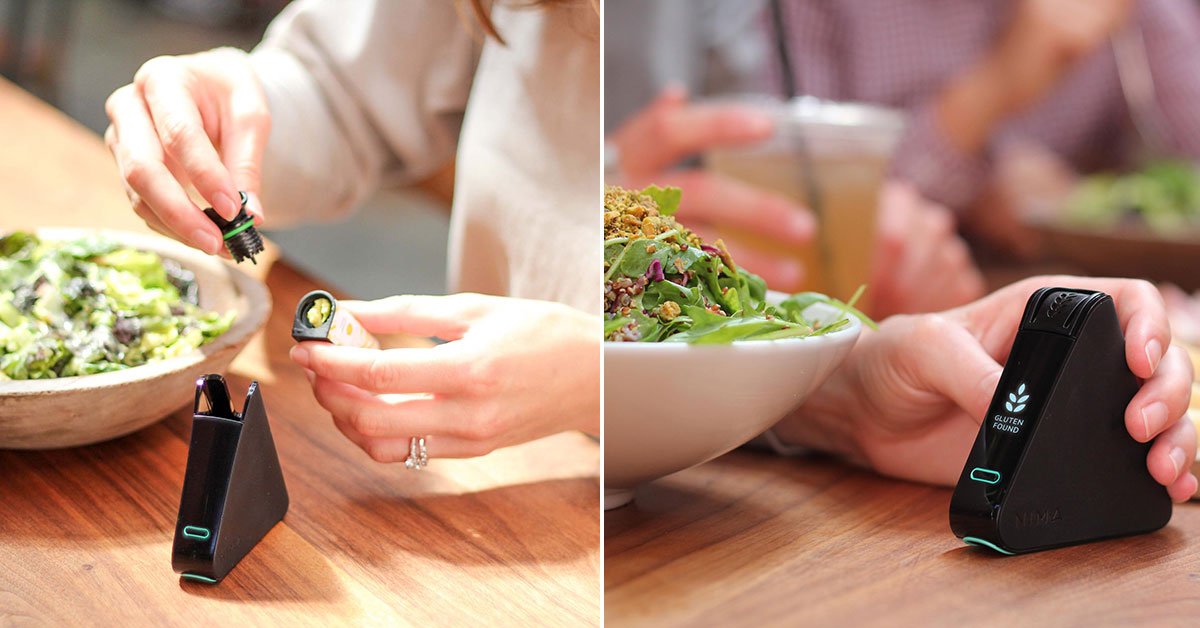Bon Appétit Tests ‘World’s First Portable, Connected Gluten Sensor’
- by Guest

The Nima Gluten Sensor in action | Photos courtesy Nima
University campuses across the country are accommodating a growing number of students with intolerances and life-threatening food allergies. For many students, this is their first time away from home making their own food choices. Many do not know how to cook and must rely on school officials and their food service team to help them safely navigate dining options.
At the same time, according to the Celiac Disease Foundation, approximately one out of every 100 persons worldwide is affected by Celiac disease and another 2.5 million Americans are undiagnosed. For those with gluten and wheat sensitivities, prolonged ingestion of gluten may cause permanent gastrointestinal damage that leads to malabsorption and vitamin deficiencies. Providing safe dining options requires careful attention to food handling — any ingredient that passes through the kitchen must be verified to be made without gluten-containing ingredients and not be exposed to cross-contact during the production process.
A new startup based in San Francisco called Nima has invented what it calls the world’s first portable, connected food sensor. Bon Appétit’s Director of Nutrition and Wellness Terri Brownlee recently led a team that partnered with Nima on a pilot project to use Nima Gluten Sensors in five dining facilities at a large East Coast college campus.
How It Worked
Paid student ambassadors were recruited to assist in front-of-house food sample testing during peak dining periods. Not all the students personally followed gluten-free lifestyles, but they participated in a mandatory pre-study meeting to learn about celiac disease, gluten intolerance, foods that contain gluten, and how to use the Nima sensor. Student ambassadors checked out the devices from the cafés and recorded their results. Students were asked to test all foods that naturally do not contain gluten, not just menu items marketed under “Avoiding Gluten.” They were also asked not to test foods that were obvious sources of gluten, like bagels or chicken-noodle soup.
Separately, back-of-house testing using the Nima sensor was completed by Bon Appétit’s residential dietitian on campus to validate Bon Appétit’s gluten-handling practices. The campus runs an Avoiding Gluten program where meals made without gluten-containing ingredients (MWGCI) are prepared in-house and served at cafés.
During the study, if gluten was found in any of the foods marketed under the “Avoiding Gluten” program, an emergency protocol was triggered. Students were instructed to alert the manager when gluten presence was found in these foods, and the manager then would remove the food item from service to indicate that it did not meet the Avoiding Gluten standards.
The Results
A total of 839 tests were completed (591 student tests + 248 dietitian tests). Of the 220 foods sampled that were labeled as MWGCI, only 11% (26 samples) indicated trace gluten was present. None reported a high gluten level. Of the 333 foods samples that were not labeled MWGCI but didn’t contain obvious sources of gluten, 277 were found to be without detectable levels of gluten; 38 samples were excluded as they were conducted on obvious sources of gluten such as a regular bagel or noodles.
Beyond the testing, Nima was able to provide comparison information from their database. The percentage of gluten found during this study (around 11%) is much lower than the average 30% positives the Nima team sees in their collected data from existing device users. Nima representatives said that this indicates that Bon Appétit’s standard precautions and best practices are helping to mitigate the risk to guests.
Other important findings: Self-serve areas had higher gluten presence than made-to-order stations run by chefs. Gluten was more likely to be present later in the meal period than at the beginning of service (both lunch and dinner). The largest café location also had the highest percentages of gluten presence.
Next Steps
The case study has proven to Terri’s team that Nima could be a useful tool to have available to guests and more importantly to ensure that Bon Appétit’s food-handling practices measure up to quantifiable standards. Even with a rigorous food allergen management program, some cross-contact still existed, especially in self-service areas and later in service periods. Nima was able to help identify the sites where there is the most risk and where practices need further review. The company noted that heavily trafficked café areas may warrant increased attention and dedication. Because of this, separate protocols should also be established for students who require gluten-free meals for medical reasons versus those who are living a gluten-free lifestyle.
Bon Appétit is currently exploring further ways to incorporate the Nima Gluten Sensor into the company’s food allergen awareness program.
— Adapted from case study by Nima by Terri Brownlee, Director of Nutrition and Wellness